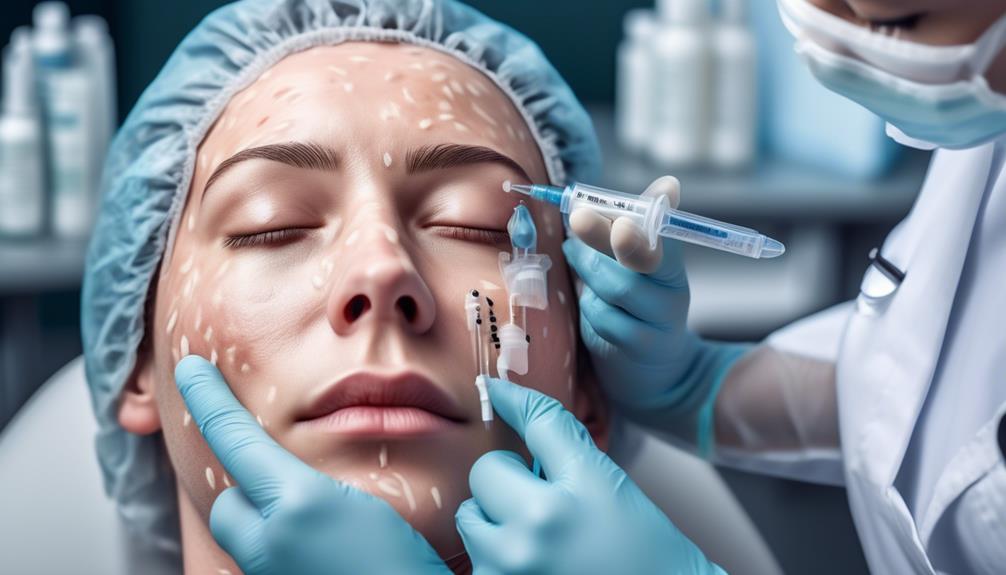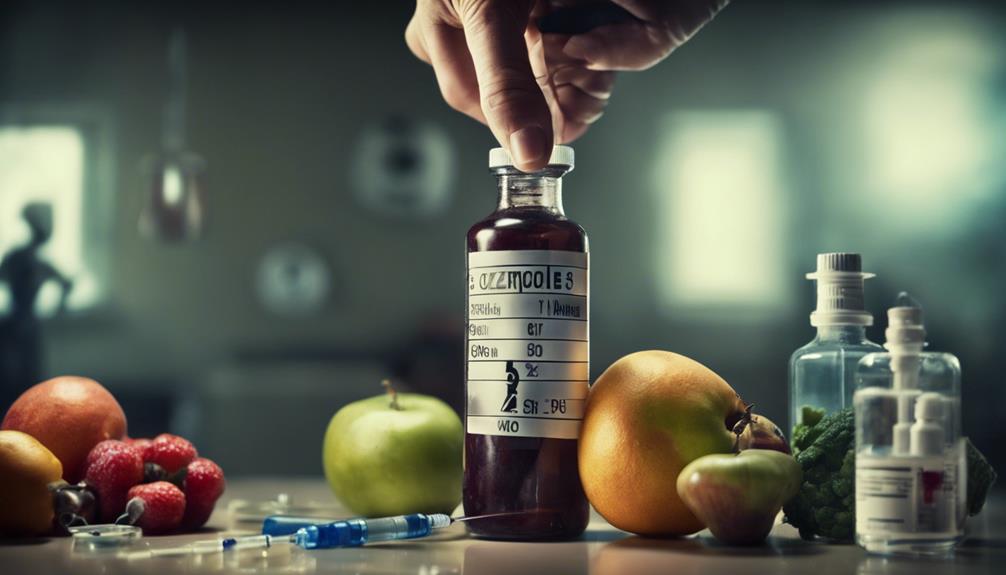Injection Side Effects: Unveiling Hidden Risks
Have you ever wondered about the potential risks lurking beneath the surface of seemingly routine injections? From cosmetic procedures to medical treatments, the allure of quick fixes often overshadows the hidden dangers that may accompany them.
As you consider the implications of injection side effects, it becomes imperative to unravel the layers of risk that are often obscured from view. But what exactly are these hidden risks, and how can they impact your decision-making process when it comes to seeking treatment?
Key Takeaways
- Swelling, bruising, infection, necrosis, and nerve damage are common side effects of injections, particularly in fat grafting procedures.
- Fat embolism syndrome is a rare but potentially fatal complication associated with injections.
- Transparency in reporting clinical trials is crucial for understanding the potential risks of injections.
- Patients should be well-informed, advocate for transparency in clinical trial data, and seek information from reliable medical sources before undergoing any injection-based procedure.
Common Side Effects of Injections
Commonly, swelling and bruising can occur as side effects of injections, particularly fat grafting. These common side effects are usually temporary and subside within a few days or weeks. However, it's important to be aware of the potential side effects that can arise from injections.
Infection is a possible side effect that can occur, although it's considered rare. It's crucial to follow proper post-injection care to minimize the risk of infection. Additionally, necrosis, which is tissue death, can occur if the injected area doesn't receive sufficient oxygen or nutrients.
Complications from anesthesia are also possible adverse events that can occur during injection procedures. It's essential to discuss any concerns about anesthesia with your healthcare provider before undergoing the procedure.
Furthermore, although rare, fat embolism syndrome is a potentially fatal complication that can occur, emphasizing the importance of carefully considering the risks and benefits of injections. Always consult with a qualified healthcare professional to fully understand the potential side effects and risks associated with any injection procedure.
Serious Complications From Injections
Serious complications from injections can include rare but potentially fatal conditions such as fat embolism syndrome. While swelling and bruising are common side effects of fat grafting injections, there are more severe adverse effects to be aware of. Infection, although rare, is a potential risk associated with these injections. Additionally, necrosis, the death of body tissue, can occur due to the lack of oxygen or nutrients from fat grafting injections. Complications from anesthesia can also arise, adding another layer of risk to the procedure.
It is crucial to be aware of these potential serious complications, especially considering a rare but fatal condition like fat embolism syndrome. This condition occurs when fat tissue enters the bloodstream and blocks blood vessels, leading to serious consequences. A study published in the New England Journal of Medicine found that fat embolism syndrome can occur after medical treatments involving fat injections.
Understanding the potential serious complications from injections is vital when considering medical treatments. Therefore, it's essential to discuss these risks with a healthcare professional and carefully weigh the potential benefits against the possible adverse effects before proceeding with any injection procedure.
Unforeseen Risks of Injections

When considering injections, it's important to be aware of unforeseen risks that may impact the success of the procedure. Some side effects, such as swelling, bruising, infection, necrosis, and nerve damage, can affect the outcome of fat grafting procedures.
The New England Journal of Medicine and The American Society of Plastic Surgeons have conducted studies on the long-term effects and risks of fat grafting, highlighting the importance of understanding potential side effects. However, there's a concern about missing data in published studies, which can lead to a lack of transparency regarding adverse effects.
This emphasizes the need for patients to advocate for transparency in clinical trial data. Informed consent for medical treatments, including injectable medications and fat grafting, should also consider the potential impact of nocebo effects.
It's important for patients to be well-informed and to advocate for transparency in clinical trial data to ensure that potential side effects are thoroughly understood, especially in the case of fat grafting procedures.
Managing Injection-Related Adverse Events
To effectively manage injection-related adverse events, it's crucial to promptly address any signs of swelling, bruising, infection, or other potential complications. After receiving an injection, it's important to monitor the injection site for any unusual reactions.
Swelling and bruising are common side effects, but excessive or prolonged swelling could indicate a more serious issue. If you notice any signs of infection such as redness, warmth, or discharge at the injection site, it's essential to seek medical attention promptly. Additionally, if you experience increasing pain or any unexpected symptoms after the injection, it's important to consult a healthcare professional.
Managing injection-related adverse events also involves being aware of potential hidden risks. Some adverse events may not be immediately apparent and could manifest over time. Therefore, it's crucial to stay informed about the potential side effects associated with the specific type of injection you receive. Reliable medical sources can provide valuable information on the potential risks and side effects.
Recognizing Long-Term Effects of Injections

Have you considered the potential long-term effects of fat grafting, a minimally invasive procedure involving the transfer of fat cells from one area of the body to another? While fat grafting can offer aesthetic benefits, it's crucial to recognize the potential long-term effects and risks associated with this injection-based procedure. Understanding the long-term impact of injections is essential in making an informed decision about your healthcare. Consider the following table to weigh the long-term effects and risks of injections:
| Long-Term Effects | Potential Risks | Hidden Risks |
|---|---|---|
| Nerve Damage | Infection | Missing Data |
| Calcification of Grafted Fat | Necrosis | Transparency in Reporting |
| Clinical Trials |
Recognizing the long-term effects of injections, such as fat grafting, goes beyond the immediate side effects. It involves acknowledging potential risks like nerve damage, calcification of grafted fat, and the importance of transparency in reporting clinical trials. By understanding these long-term effects and hidden risks, you can make informed decisions about your medical treatments. Therefore, it is crucial to seek information from reliable medical sources and consider the potential long-term implications before undergoing any injection-based procedure.
Frequently Asked Questions
What Are the Long Term Side Effects of Bbl?
Long-term side effects of a Brazilian butt lift may include scarring risks, skin discoloration, nerve damage, infection concerns, and tissue hardening. It's important to discuss these potential risks with your healthcare provider before considering the procedure.
What Are the Long Term Side Effects of Fat Transfer?
You might experience scarring risk, tissue necrosis, infection potential, numbness concerns, and cosmetic dissatisfaction as long-term side effects of fat transfer. The procedure's outcomes can be unpredictable and may require additional treatments for improvement.
Conclusion
Now that you're aware of the potential risks and side effects of injections, it's important to do your research and ask questions before undergoing any procedures.
Don't be afraid to seek out multiple opinions and make sure you fully understand the possible outcomes.
Remember, being informed is the best way to protect yourself and make the right decision for your health and well-being.
Injection Side Effects: Unveiling Hidden Risks
Have you ever wondered about the potential risks lurking beneath the surface of seemingly routine injections? From cosmetic procedures to medical treatments, the allure of quick fixes often overshadows the hidden dangers that may accompany them.
As you consider the implications of injection side effects, it becomes imperative to unravel the layers of risk that are often obscured from view. But what exactly are these hidden risks, and how can they impact your decision-making process when it comes to seeking treatment?
Key Takeaways
- Swelling, bruising, infection, necrosis, and nerve damage are common side effects of injections, particularly in fat grafting procedures.
- Fat embolism syndrome is a rare but potentially fatal complication associated with injections.
- Transparency in reporting clinical trials is crucial for understanding the potential risks of injections.
- Patients should be well-informed, advocate for transparency in clinical trial data, and seek information from reliable medical sources before undergoing any injection-based procedure.
Common Side Effects of Injections
Commonly, swelling and bruising can occur as side effects of injections, particularly fat grafting. These common side effects are usually temporary and subside within a few days or weeks. However, it's important to be aware of the potential side effects that can arise from injections.
Infection is a possible side effect that can occur, although it's considered rare. It's crucial to follow proper post-injection care to minimize the risk of infection. Additionally, necrosis, which is tissue death, can occur if the injected area doesn't receive sufficient oxygen or nutrients.
Complications from anesthesia are also possible adverse events that can occur during injection procedures. It's essential to discuss any concerns about anesthesia with your healthcare provider before undergoing the procedure.
Furthermore, although rare, fat embolism syndrome is a potentially fatal complication that can occur, emphasizing the importance of carefully considering the risks and benefits of injections. Always consult with a qualified healthcare professional to fully understand the potential side effects and risks associated with any injection procedure.
Serious Complications From Injections
Serious complications from injections can include rare but potentially fatal conditions such as fat embolism syndrome. While swelling and bruising are common side effects of fat grafting injections, there are more severe adverse effects to be aware of. Infection, although rare, is a potential risk associated with these injections. Additionally, necrosis, the death of body tissue, can occur due to the lack of oxygen or nutrients from fat grafting injections. Complications from anesthesia can also arise, adding another layer of risk to the procedure.
It is crucial to be aware of these potential serious complications, especially considering a rare but fatal condition like fat embolism syndrome. This condition occurs when fat tissue enters the bloodstream and blocks blood vessels, leading to serious consequences. A study published in the New England Journal of Medicine found that fat embolism syndrome can occur after medical treatments involving fat injections.
Understanding the potential serious complications from injections is vital when considering medical treatments. Therefore, it's essential to discuss these risks with a healthcare professional and carefully weigh the potential benefits against the possible adverse effects before proceeding with any injection procedure.
Unforeseen Risks of Injections

When considering injections, it's important to be aware of unforeseen risks that may impact the success of the procedure. Some side effects, such as swelling, bruising, infection, necrosis, and nerve damage, can affect the outcome of fat grafting procedures.
The New England Journal of Medicine and The American Society of Plastic Surgeons have conducted studies on the long-term effects and risks of fat grafting, highlighting the importance of understanding potential side effects. However, there's a concern about missing data in published studies, which can lead to a lack of transparency regarding adverse effects.
This emphasizes the need for patients to advocate for transparency in clinical trial data. Informed consent for medical treatments, including injectable medications and fat grafting, should also consider the potential impact of nocebo effects.
It's important for patients to be well-informed and to advocate for transparency in clinical trial data to ensure that potential side effects are thoroughly understood, especially in the case of fat grafting procedures.
Managing Injection-Related Adverse Events
To effectively manage injection-related adverse events, it's crucial to promptly address any signs of swelling, bruising, infection, or other potential complications. After receiving an injection, it's important to monitor the injection site for any unusual reactions.
Swelling and bruising are common side effects, but excessive or prolonged swelling could indicate a more serious issue. If you notice any signs of infection such as redness, warmth, or discharge at the injection site, it's essential to seek medical attention promptly. Additionally, if you experience increasing pain or any unexpected symptoms after the injection, it's important to consult a healthcare professional.
Managing injection-related adverse events also involves being aware of potential hidden risks. Some adverse events may not be immediately apparent and could manifest over time. Therefore, it's crucial to stay informed about the potential side effects associated with the specific type of injection you receive. Reliable medical sources can provide valuable information on the potential risks and side effects.
Recognizing Long-Term Effects of Injections

Have you considered the potential long-term effects of fat grafting, a minimally invasive procedure involving the transfer of fat cells from one area of the body to another? While fat grafting can offer aesthetic benefits, it's crucial to recognize the potential long-term effects and risks associated with this injection-based procedure. Understanding the long-term impact of injections is essential in making an informed decision about your healthcare. Consider the following table to weigh the long-term effects and risks of injections:
| Long-Term Effects | Potential Risks | Hidden Risks |
|---|---|---|
| Nerve Damage | Infection | Missing Data |
| Calcification of Grafted Fat | Necrosis | Transparency in Reporting |
| Clinical Trials |
Recognizing the long-term effects of injections, such as fat grafting, goes beyond the immediate side effects. It involves acknowledging potential risks like nerve damage, calcification of grafted fat, and the importance of transparency in reporting clinical trials. By understanding these long-term effects and hidden risks, you can make informed decisions about your medical treatments. Therefore, it is crucial to seek information from reliable medical sources and consider the potential long-term implications before undergoing any injection-based procedure.
Safe Practices When Using Injection-Based Products
When considering any injection-based product, *following proper safety protocols is crucial* for minimizing risks and ensuring optimal results. Adhering to these guidelines can help in reducing the likelihood of complications:
- **Consult a Qualified Healthcare Provider:** Before opting for any injection procedure, consult with a healthcare provider who specializes in the specific treatment you're considering. This ensures you are receiving professional advice tailored to your unique medical history and needs.
- **Follow Pre-Injection and Post-Injection Care Instructions:** Care instructions provided by your healthcare provider are crucial. Ensure to follow these instructions meticulously to minimize risks such as infection or other adverse effects.
- **Use Sterile Equipment:** Always ensure that all equipment used during the procedure is sterile. This can significantly reduce the risk of infections.
- **Monitor for Adverse Reactions:** Keep an eye on the injection site and your overall health for any signs of adverse reactions. Immediate medical attention is vital if symptoms worsen or if you experience unusual side effects.
- **Understand the Product:** Be well-informed about the product being used for the injection, including its ingredients, potential side effects, and how it has been tested and reviewed by medical professionals.
How to Store Injection-Based Products
Proper storage of injection-based products is essential to maintain their efficacy and safety.
- **Refrigeration:** Some injectable products require refrigeration. Always check the product label or consult your healthcare provider to determine the appropriate storage conditions.
- **Avoid Freezing:** Freezing can damage certain injectable products. Ensure they are stored within the recommended temperature range.
- **Keep Away from Direct Light:** Many injectable products need to be stored in a cool, dark place. Exposure to direct light can degrade the product.
- **Secure Storage:** Store injectable products in a secure location out of reach of children and pets to prevent accidental usage or interference.
Additional Resources
For more detailed information on injection side effects and how to manage them, the following resources can be highly beneficial:
- New England Journal of Medicine: Refer to studies and articles on injection-related adverse events and their management.
- The American Society of Plastic Surgeons: Provides comprehensive resources on cosmetic procedures, including fat grafting and its potential risks.
- Mayo Clinic: Offers detailed patient guides on various medical procedures and their side effects.
How to Clean and Maintain Injection Sites
Proper cleaning and caring for the injection site is crucial for preventing infections and promoting healing.
- **Use Antiseptics:** Clean the injection site with an antiseptic solution before and after the procedure.
- **Avoid Touching the Area:** Refrain from touching the injection site with unwashed hands to reduce the risk of contamination.
- **Regular Inspection:** Regularly inspect the injection site for any signs of infection such as redness, pus, or unusual swelling, and contact your healthcare provider if these appear.
What to Do If You Experience Complications
If you experience any complications following an injection, such as unexpected swelling, severe pain, or signs of infection, it's imperative to seek medical attention promptly.
- **Contact Your Healthcare Provider:** Notify your healthcare provider about any adverse effects you experience. They can provide guidance on managing symptoms and may need to adjust your treatment plan.
- **Emergency Care:** If you experience severe symptoms such as difficulty breathing, severe allergic reactions, or intense chest pain, seek emergency medical care immediately.
- **Follow-Up Visits:** Schedule follow-up appointments with your healthcare provider to monitor your progress and address any lingering concerns.



